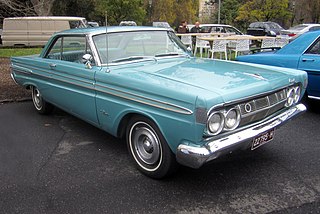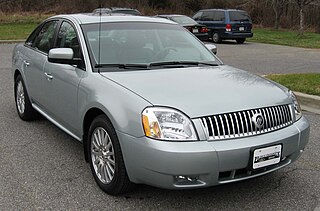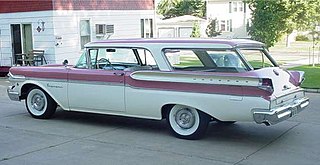
Edsel is a discontinued division and brand of automobiles that was produced by the Ford Motor Company in the 1958 to 1960 model years. Deriving its name from Edsel Ford, son of company founder Henry Ford, Edsels were developed in an effort to give Ford a fourth brand to gain additional market share from Chrysler and General Motors. Established as an expansion of the Lincoln-Mercury Division to three brands, Edsel shared a price range with Mercury; the division shared its bodies with both Mercury and Ford.

Mercury was a brand of mid-priced automobiles produced by American manufacturer Ford Motor Company between 1938 and 2011 with 1939 being the first model year. It stood as its own line within Ford until 1945, and thereafter formed half of Ford's Lincoln-Mercury Division. Created by Edsel Ford in 1938 to bridge the gap between the Ford and Lincoln model lines, its principal competition was General Motors' Buick and Oldsmobile divisions, and Chrysler Corporation's DeSoto and Chrysler brands.

The Mercury Comet is an automobile that was produced by Mercury from 1960–1969 and 1971–1977 — variously as either a compact or an intermediate car. In its first two years, it was marketed as the "Comet" and from 1962 as the "Mercury Comet".

The Ford Country Squire is a series of full-size station wagons that were assembled by American automaker Ford. Positioned as the top-level station wagon of the Ford division, the Country Squire was distinguished by woodgrain bodyside trim. From 1950 through the 1991 model years, eight generations of the Country Squire were produced. Following the discontinuation of Edsel Bermuda, Mercury marketed the Mercury Colony Park as a divisional counterpart of the Country Squire, sharing bodywork and trim while the Mercury was not available with a six cylinder engine and was more expensive due to the optional equipment on the Ford that was standard on the Mercury.

The Mercury Montego is a nameplate that was applied to three separate generations of vehicles marketed by the Mercury division of Ford Motor Company. Taking its name from Montego Bay, Jamaica, the nameplate made its first appearance for 1967 in the Canadian market as part of the Mercury-derived Meteor model line. For 1968, the Mercury Montego made its debut across North America, becoming the Mercury counterpart of the Ford Torino intermediate-size model line for two generations.

The Ford LTD is a range of automobiles manufactured by Ford for the 1965 to 1986 model years. Introduced as the highest trim level of the full-size Ford model range, the LTD moved the Ford range upmarket, offering options and features previously reserved for Mercury and Lincoln vehicles. For much of its production life, the LTD competed against the Chevrolet Caprice ; the Mercury Marquis served as its divisional counterpart from 1967 until 1986.

Meteor was a marque of automobiles offered by Ford Motor Company of Canada from 1949 to 1976. The make was retired for the 1962 and 1963 model years, when the name was used for the Mercury Meteor sold in the United States. It succeeded the Mercury 114, a Canadian-market Mercury based on the Ford, the "114" name being taken from the car's wheelbase.

The Mercury Montclair is a series of full-size sedans that were manufactured and marketed over five generations by the Mercury division of Ford. The nameplate was used by the division twice, from the 1955 to the 1960 model years and from the 1964 to the 1968 model years. The model was offered as two-door and four-door hardtops, four-door pillared sedan, and a two-door convertible.

The Mercury Park Lane is a full-sized automobile that was produced by the Mercury division of Ford Motor Company. While not officially introduced as the replacement of the Mercury Turnpike Cruiser, the Park Lane became the flagship of the Mercury model line upon its introduction. The second-generation Park Lane was positioned above the Mercury Montclair.

The Mercury Colony Park is an American luxury full-size station wagon that was marketed by the Mercury division of Ford Motor Company between 1957 and 1991. Distinguished by its simulated wood-grain paneling, the Colony Park was marketed as either the premium-trim or the sole full-size station wagon offering of the division. Following the 1960 demise of Edsel, full-size Mercury vehicles shared bodywork with Ford; the Colony Park served as the counterpart of the Ford Country Squire through 1991.

The Ford LTD II is an automobile produced and marketed by Ford Motor Company between 1977 and 1979 in the United States and Canada. Deriving its name from the full-sized Ford LTD model line, the intermediate LTD II consolidated the Ford Torino and Gran Torino model lines, with the Ford Elite replaced by the Ford Thunderbird. Offered in a two-door sedan, four-door sedan, and station wagon, the LTD II also served as a basis for the final generation of the Ford Ranchero coupe utility.

The Ford Fairlane is an automobile model that was sold between the 1955 and 1970 model years by Ford in North America. Taking its name from the Dearborn, Michigan estate of Henry Ford, the Fairlane nameplate was used for seven different generations of vehicles. Through its production, the model line would be marketed in a wide variety of body styles, including two-door and four-door sedans, two-door and four-door hardtops, station wagons, and both traditional and retractable-hardtop convertibles.

The Mercury Marquis is a model line of automobiles marketed by Mercury from 1967 to 1986. Deriving its name from a title of French nobility, the Marquis was introduced as the divisional counterpart of the Ford LTD; four generations of the two model lines were paired through rebranding. Initially slotted as the flagship Mercury full-size range, the Marquis would serve as the basis for the later Mercury Grand Marquis.

The Ford Falcon is a model line of cars that was produced by Ford from the 1960 to 1970 model years. Though preceded by the Rambler American, the Falcon was the first compact car marketed by the Big Three American manufacturers.

The 1949 Ford is a line of cars produced by Ford from the 1949 to 1951 model years. The successor to the prewar 1941 Ford, the model line was the first full-size Ford designed after World War II, becoming the first Ford car line released after the deaths of Edsel Ford and Henry Ford. From 1946 to 1948, each of the American Big Three concentrated on the restoration of car production, offering updated versions of their 1941-1942 model lines. Released in June 1948, the 1949 Ford was the first major "postwar" American car line, beating Chevrolet to market by six months and Plymouth by nine.

The Mercury Monterey is a series of full-size cars that were manufactured and marketed by the Mercury division of Ford from 1950 to 1974. Deriving its name from Monterey Bay, the initial Mercury Monterey served as the top-of-the-line two-door sedan model for 1950 and 1951 to compete with the hardtop models of Oldsmobile and Buick. It came with a vinyl roof covering, upgraded upholstery, and other features. The hardtop was introduced for 1952. During its production, the Monterey would be offered in multiple body styles, ranging from coupes, convertibles, sedans, hardtops, and station wagons.
Full-size Ford is a term adopted for a long-running line of Ford vehicles with a shared model lineage in North America. Originating in 1908 with the Ford Model T, the line ended in 2019 with the Ford Taurus, as Ford withdrew from the full-sized sedan segment in North America. Across 111 years, 15 generations, and over 60 million examples of the model line were produced across over 50 model nameplates. By contrast, the longest-running single nameplate worldwide is the Chevrolet Suburban, in use since the 1935 model year.

The Mercury Voyager is a station wagon that was sold by the Mercury division of Ford for the 1957 and 1958 model years. For the 1957 model year, Mercury created a model range of station wagons distinct from sedans, following Ford. The Voyager served as the mid-range offering, slotted above the base-trim Mercury Commuter, with the woodgrained Colony Park serving as the top-range offering.

The Mercury S-55 is a full-size car that was marketed by the Mercury division of the Ford Motor Company during the 1960s. Developed as a performance-oriented version of the mid-level Mercury Monterey, the S-55 was the largest vehicle of the Mercury "S" (Special) range introduced in 1962; its Ford equivalent was the Ford Galaxie 500XL and competed in the full-size luxury sport coupe market segment against the Chrysler 300H.

The Mercury Marauder is an automobile nameplate that was used for three distinct full-size cars produced by the Mercury division of Ford Motor Company. Deriving its name from the most powerful engines available to the Mercury line, the Marauder was marketed as the highest-performance version of the full-size product range.



























